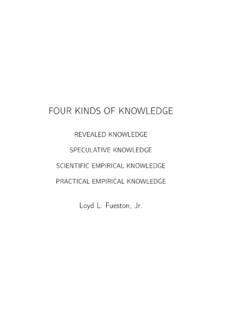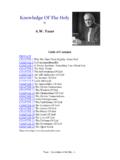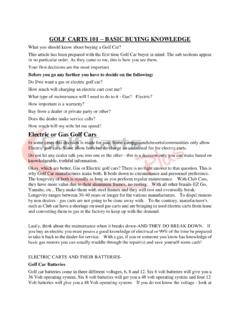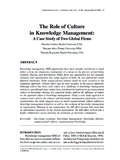Transcription of Knowledge in perception and illusion - Richard …
1 Knowledge in perception and illusion1 Knowledge in perceptionand illusionRichard L GregoryFrom: Phil. Trans. R. Soc. Lond. B (1997) 352, 1121 1128 Department of Psychology, University of Bristol, 8 WoodlandRoad, Bristol BS8 1TA UKSummaryFollowing Hermann von Helmholtz, who described visualperceptions as unconscious inferences from sensory data andknowledge derived from the past, perceptions are regarded assimilar to predictive hypotheses of science, but arepsychologically projected into external space and accepted as ourmost immediate reality. There are increasing discrepanciesbetween perceptions and conceptions with science s advances,which makes it hard to define illusion . Visual illusions canprovide evidence of object Knowledge and working rules forvision, but only when the phenomena are explained and tentative classification is presented, in terms of appearances andkinds of large contribution of Knowledge from the past for visionraises the issue: how do we recognize the present, withoutconfusion from the past.
2 This danger is generally avoided as thepresent is signalled by real-time sensory inputs perhaps flaggedby qualia of Intelligence and KnowledgePhilosophy and science have traditionally separated intelligencefrom perception , vision being seen as a passive window on theworld and intelligence as active problem-solving. It is a quiterecent idea that perception , especially vision, requires intelligentproblem-solving based on is something of a paradox confounding intelligence andknowledge, for one thinks of knowledgeable people as beingspecially intelligent and yet more Knowledge can reduce theintelligence needed for solving problems. The paradox is resolved,when we consider two senses of intelligence : active processingof information (as supposedly measured in IQ tests) and availableanswers (as in military intelligence ) These senses of intelligence have been named by rough analogy with creatingand the storing of energy as, potential intelligence and kineticintelligence (Gregory 1987).
3 The notion is that stored-from-the-past potential intelligence of Knowledge , is selected and applied tosolve current perceptual problems by active processing of kineticintelligence. The more available Knowledge , the less processing isrequired; however, kinetic intelligence is needed for buildinguseful Knowledge , by learning through discovery and testing. (Theanalogy is imperfect because Knowledge is not , these terms may be useful though, apart from secretknowledge, potential intelligence is not diminished by use.)When almost complete answers are available, Knowledge takes thedominating role. Then top-down becomes more important than bottom-up , which may be so for human vision. (Remarkably,there are more downwards fibres from the cortex to the lateralgeniculate bodies LGN) relay stations than bottom-up from theeyes (Sillito 1995).
4 Errors of perception (phenomena of illusions) can be due toknowledge being inappropriate or being misapplied. So illusionsare important for investigating cognitive processes of that Knowledge makes a major contribution to humanvision is recent, remaining controversial. This applies even moreto the machine vision of artificial intelligence. Perhaps progress inartificial intelligence has been delayed through failure to recognizethat artificial potential intelligence of Knowledge is needed forcomputer vision to be comparable to was the German polymath, Hermann von Helmholtz (182l 1894) who introduced the notion that visual perceptions areunconscious inferences (von Helmholtz 1866). For vonHelmholtz, human perception is but indirectly related to objects,being inferred from fragmentary and often hardly relevant datasignalled by the eyes, so requiring inferences from Knowledge ofthe world to make sense of the sensory signals.
5 There are,however, theorists who try to maintain direct accounts of visualperception as requiring little or no Knowledge , notably followersof the American psychologist J. J. Gibson (l904 l979) whosebooks The perception of the Visual World (1950) and The SensesConsidered as Perceptual Systems (1966) remain influential. inplace of Knowledge and inference, Gibson sees vision as givendirectly by available information 'picked-up from the ambientarray of light, with what he calls affordances giving object-significance to patterns of stimulation without recourse to storedknowledge or processing intelligence. The affordance notionmight be seen as an extension of the ethologist s concept of innate releasers , which trigger innate behaviour such as robinsresponding aggressively to a red patch.
6 This fits Gibson s ecological optics ; but how new objects, such as telephones, arcrecognized without acquired Knowledge is far from clear. Tomaintain that perception is direct, without need of inference orknowledge, Gibson generally denied the phenomena of von Helmholtz s lead we may say that knowledgeis necessary for vision because retinal images are inherentlyambiguous (for example for size, shape and distance of objects).and because many properties that are vital for behaviour cannot besignalled by the eyes, such as hardness and weight, hot or cold,edible or poisonous. For von Helmholtz, ambiguities are usuallyresolved, and non-visual object properties inferred, fromknowledge by unconscious inductive inference from what issignalled and from Knowledge of the object world.
7 It is a smallstep (Gregory l968 a, b, 1980) to say that perceptions arehypotheses, predicting unsensed characteristics of objects, andpredicting in time, to compensate neural signalling delay(discovered by von Helmholtz in 1850), so reaction time isgenerally avoided, as the present is predicted from delayedsignals. This has recently been investigated with elegantexperiments by Nijhawan (1997). Further time prediction freeshigher animals from the tyranny of control by reflexes, to allowintelligent behaviour into anticipated is a key point that vision is not only indirectly related toobjects, but also to stimuli. As Helmholtz appreciated (Boring1950, p. 304), this follows from the law of specific energies,proposed by his teacher, Johannes Muller.
8 It is perhaps betternamed the law of specific qualities: any afferent nerve signals thesame quality or sensation whatever stimulates it. Thus we seecolours not only from light but also when the eyes aremechanically pressed, or stimulated electrically. We may regardeyes and the other sense organs as designed by natural selection toallow the universal neural code of action potentials to signal agreat variety of object properties, routed to specialized brainregions to create qualities of colour and touch, sounds and so on(colours being generated by a specialized brain module in area V4of the striate cortex (Zeki 1993). It was clear to Newton in Opticks(1704) that it is strictly incorrect to say that light is , light evokes sensations of colours in suitable eyes andbrains.)
9 perceptions , such as colours, are psychologically projectedinto accepted external space. This projection is demonstratedmost clearly with retinal photographs of after-images, whichappear on the surfaces of external objects, or are projected intoouter essential problem for vision is perceiving scenes andobjects in a three-dimensional external world, which is veryKnowledge in perception and illusion2different from the flat ghostly images in eves. Some phenomena ofillusion provide evidence for the uses of Knowledge for vision;this is revealed when it is not appropriate to the situation and socauses a systematic error, even though the physiology is workingnormally. A striking example is illustrated in the 1.
10 Photographs of a rotated hollow mask: (a) and (b) (blackhat) show the front and side truly convex view; (d) (white hat) showsthe inside of the mask; it appears convex although it is truly hollow;(c) is curiously confusing as part of the hollow inside is seen asconvex, combined with the truly convex face. This is even morestriking with the actual rotating mask. Viewing the hollow mask withboth eyes it appeal s convex, until viewed from as close as a metreor so. Top-down Knowledge of faces is pitted against bottom-upsignalled information. The face reverses each time a critical viewingdistance is passed, as downwards Knowledge or upwards signalswin. (This allows comparison of signals against Knowledge bynulling.)










